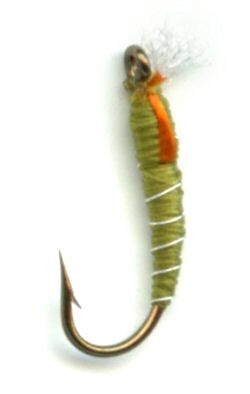Orange Cheeked Olive Buzzer Midge Nymph
If you are fishing water that is known for big fish you can still use small flies. A fly tying old work colleague of mine, Christopher Reeves, has a photograph on his website of a huge pike he caught on a natural gold ribbed hare’s ear nymph. This could easily have been an Orange Cheeked Olive Buzzer Midge Nymph.

BUZZER MIDGE FLY PATTERNS. Hook size 12 14 16 18 20 24 - $US each
Most fishermen have personal favorite flies they use again and again. In a survey many anglers claimed to carry out 90% of their trout fly fishing with just one type of fly. Notice I said type of fly not just one particular fly. Many trout fishermen swear by buzzers, small slim nymphs that are usually coated in epoxy glue. When fishing these very productive flies remember two words “simple” and “slow”. These two watch words can apply to all types of nymph fishing. Many trout fishermen spoil their chances by forgetting the importance of these two rules. The longer you take to fish out a cast, the more offers you will get. This will lead to hooking more fish. It is impossible to fish epoxy buzzer nymphs too slowly.
The near static nymphing technique known as the “bung” is effective. It makes you realize how trout will take nymphs just hanging in the current. To catch fish with buzzer fly patterns retrieve as slow as possible. The insects they are trying to imitate do not hold any swimming speed records. Your retrieve could be a snail like figure of eight or just movement caused by casting at right angles to the surface drift. The important thing to try and impart is the impression that, yes, your imitation fly is alive, and moves at the same speed as the real thing, which is slow. If a lurking trout sees its normal food source suddenly develop super powers and surge through the water at an abnormal speed, it will become suspicious that something is not quite right.
If you are fishing from the bankside of deep water, rather than fishing out at 90 degrees, try casting along the bank. Trout can be found very close in as some like the shelter offered by clumps of vegetation, like flag iris or over hanging shrubs and trees. On each subsequent cast make it further away from the bank than the last one until you eventually cover the water in front of you in a fan pattern. Use a floating line to start with. An alternative method is to start fishing across the breeze and gradually work your casts in towards the bank until you are casting straight down wind. Most anglers fishing with nymphs will try to position themselves on a bank that is 90 degrees to the wind. They will then cast across the wind and let the line swing round until it is parallel with the bank. If you are fishing by deepwater like at a reservoir, a take is just as likely to come when your flies are no longer being influenced by the wind and the only motion is your ultra-slow retrieve back along the bank.
The trick is to find what depth the fish are feeding and then target that depth. Find out the depth of the pool, lake or reservoir you are fishing. Tie on enough leader to get your flies deep. If you get no takes reduce the leader length and try again. Keep a tight line to the flies so you miss fewer takes. A good leader set up involves needle knotting the 22lb breaking strain butt of a long tapered leader to the fly line. Chop it off where the breaking strain drops to just 6lb. This produces a tapered section of around 11 feet long and a size three seamless ring is tied to the end. You leader set up takes shape from here. Add four feet of 6lb leader to the seamless ring and tie on another seamless ring to it’s end. Add four feet of 5lb leader. Then tie on a long 6 inch dropper to each of the seamless rings. Using rings in your rig setup offers a quick and easy way of changing droppers and tippets without having to replace a whole leader.
You can have a great days fishing by keeping the choice of flies simple. Have one fly box filled with epoxy buzzers, a few bigger nymphs and a couple of specials. That way you can concentrate on fly fishing rather than sifting through hundreds of fly patterns in different boxes. By concentrating on just a few pattern types it cuts out a great deal of wasted time. You only have to consider size and colour. Most waters have some sort of buzzer hatch on nearly every day of the year so the trout are looking for this type of food.
Another good tip is to keep direct eye contact with your flies when retrieving. Keep your rod pointing straight down the line and feel for takes. If you fish ant other way you will miss the small plucks and nips that bigger fish are prone to give. The smaller fish are generally easier to detect as they take your fly. Anyone that waits for the rod to be pulled from their hand is going to miss most of the nibbles that come their way. There is nothing fancy to this technique. It is simple and it works. What is that saying KISS keep it simple stupid. It should be keep it simple and slow.


